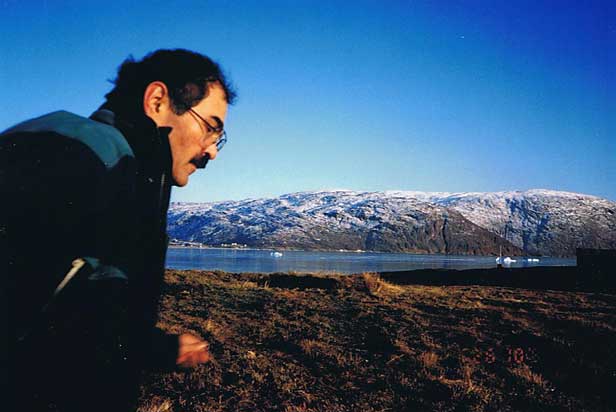Back to Exhibit

Jonasie Faber Biography
Jonasie spent his formative years in the village of Alluisup Pa, on a fjord in Southern Greenland. At the age of 10, he and his family relocated to Denmark. Longing for the sea and the spiritual independence and freedom of his boyhood, he left home at 14, working his way around much of the world as a ship hand.
While still a teenager, Faber trained on the square rigger "Georg Stage." Despite the lack of formal education, he enrolled in the Copenhagen Naval Academy, completing Officer training and becoming a Deep Sea Navigator. As an adult he returned to Greenland as a Harbour Master. Stifled by colonial policies and attitudes in Greenland, Jonas set sail again, immigrating to Canada in 1974.
European colonialism in Greenland at the time, prohibited Jonasie from fraternizing with American military and civilian personnel. Since relocating to Canada, the always social Faber, has enjoyed traveling throughout much of the continental USA and Alaska.
Over the decades, not only has Jonasie formed close relationships with people he was once banned from socializing with, he is "Granddaddy" to his three cherished American grandkids. Although Jonasie left Greenland physically, he is still very much bound to the land and culture of his ancestors. He conveys this deep, personal bond through his art.
Faber began life in Canada importing Greenlandic art, but his natural curiosity and latent talent soon took over as he taught himself to sculpt. In need of raw materials he studied prospecting. In short order he staked a claim in the mountains near his home in British Columbia and began mining soapstone.
As the years passed, he switched to purchasing more consistent quality stone from around the world. Serendipity, always a close companion of Jonasie, resulted in him living near the site of his old mineral claim many years later. There he created a small art school, passing his skills and knowledge to a new generation of Aboriginal artists, some of whom continue to make their livelihood from soapstone carving.
Through hunting and the outdoors, Faber retains a physical connection to his culture which has also lead him to the discovery of a significant archaeological site, yet to be studied in detail.
A true Renaissance man, Jonasie is also an avid amateur historian. In the late 1980's, he petitioned Greenlandic Home Rule to take action to preserve Illulissat glacier and the remains of a Viking Church dating to the year 1000. In 1991, the Greenlandic government sent him to Paris to begin the process of having the sites included in the prestigious UNESCO World Heritage List.
Jonasie envisioned a replica of Tjodhildes, the Viking Church, near the original site. Unable to secure Government funding, he partnered with his long time friend, adventurer Jay Fiondella, from Santa Monica, California. They endeavored to create a non-profit organization and hoped to complete construction by the year 2000.
News of foreign, particularly American financing, spurred the Greenlandic Government to action! They funded construction. Faber was immensely proud of his involvement, when Tjodhildes Church was featured on the cover of National Geographic Magazine, June 2010.
In 2004, the Illulissat Glacier, officially made it into the UNESCO World Heritage List, generating over $ 11 million a year in tourism for Greenland. The Viking Historical sites of Greenland, are still pending the enrollment in the UNESCO World Heritage List.
Using his eclectic interests, expertise and knowledge of several languages, Faber has also become a respected adviser to a Greenlandic member of the Danish Parliament and continues to work for the well being of Greenlandic Inuit.
Early in his long artistic career, the Danish Queen and her husband, who own at least one of his sculptures, visited one of Jonasie's art shows. Jonasie and the Prince corresponded for a number of years afterwards.
In his seventieth year, Jonasie is one of the oldest working Inuit artists. In recent years his work has evolved into more sophisticated expressions of Inuit spirituality. It is now marketed exclusively through very few international art dealers in Canada, the USA and Europe.
Tuesday - Saturday 11am - 5:30 pm & by appointment All rights reserved